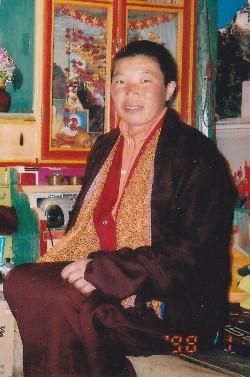
Palden Choetso, self-immolated 3 November 2011
Self-immolation as protest in tibet
Guest Editors: Carole McGranahan (University of Colorado) and Ralph Litzinger (Duke University)
Tibet has no history of self-immolation as sacrifice, religious offering, or political protest. Yet, in the last year alone, roughly thirty-five Tibetans have set themselves on fire. The overwhelming majority of self-immolators are inside Tibet, in the People’s Republic of China, and almost exclusively in northwestern Sichuan and southeastern Qinghai provinces (corresponding to the Tibetan regions of northern Kham and southern Amdo). In this special issue of Cultural Anthropology, we collectively ask why. Why are so many Tibetans resorting to the singular act of setting the body on fire? What combination of cultural, historical, political, and/or religious reasons inspire these acts?
Most of the self-immolators have been young Buddhist monks (or former monks), men in their teens and early twenties, but nuns have also immolated, as have both male and female laypeople. One of the self-immolators was a tulku/sprul ku, a respected Buddhist reincarnate lama in his forties. Two earlier Tibetan self-immolations are notable: Thubten Ngodup who in 1998 was the first Tibetan to self-immolate as a form of political protest, and Tapey who self-immolated in February 2009 following massive protests in Tibet the year before. In the spring of 2008, protests rocked the Tibetan Plateau. These were the largest, most widespread protests in Tibet since 1959 when the Dalai Lama escaped to India. For a brief while, Tibet captured the world’s attention. The protests and accompanying violence received widespread coverage inside and outside of China. The media attention eventually moved on to the devastating earthquake in Sichuan and then the summer Olympics in Beijing. Much of the world might have turned their attention elsewhere, but Tibetans did not. Contributors to this special issue know from fieldwork, travel, and correspondence that things remained tense in many Tibetan areas. If we knew this, though, we did not know that a new form of protest was in the works. We did not anticipate these dozens of self-immolations. No one saw this coming.
As we compiled this issue over the last two months, the frequency of the self-immolations increased. Updating the numbers, however, did not necessarily put us closer to comprehending the acts. How does one write about self-immolation—an act that is simultaneously politically charged, emotionally fraught, visually graphic, individually grounded, collectively felt—and what does one write? How do we intellectually make sense of these self-immolations, and how do we do so while writing in the moment, but writing from the outside?
There are no anthropologists in the self-immolation zone right now. Nor are there any foreign or Chinese journalists. These areas of Tibet are closed. As a result, there is neither on-the-ground, first-hand ethnographic research nor professional media coverage of the self-immolations inside Tibet. If anthropologists usually conduct in-depth, in-person fieldwork followed by reflection and analysis, in this instance we are unable to for political reasons. We simply do not have access to the area. Monasteries and towns linked to self-immolations were locked-down, and military troops rolled into these places, ostensibly to “protect the people” and secure “social order.” Information and images coming out were initially exclusively via Tibetans sending them out to the exile community. The global media could not get to Tibet, and the Chinese media was noticeably silent; Time magazine declared the Tibetan self-immolations the n. 1 most under-reported story of 2011.
Foreign journalists began to sneak into closed areas to cover the story, but the self-immolations did not make the front page of the New York Times until Jamphel Yeshi set himself on fire on 26 March 2012 in New Delhi. Photographers from Reuters and the Associated Press were on the scene, and shot haunting, powerful images of his self-immolation. They were immediately published around the world. While the self-immolations are now an active media story, as well as scholarly and governmental concern, we still do not know how or when this series of self-immolations will end.
We turn now to the essays, a combination of poignant reflections on the impossibility yet necessity of interpretation, focused analyses of possible ways of making sense of self-immolation, and efforts to speak to broader audiences, to translate ethnographic knowing into meaningful commentary on life and death, on the all-too-real deaths of over thirty Tibetans. Each of these essays was difficult for their author to write, and we gratefully acknowledge their willingness to write about a difficult topic involving political risk.
http://culanth.org/?q=node%2F526